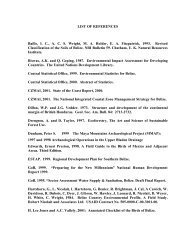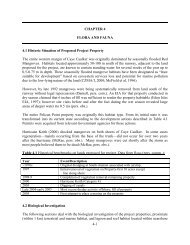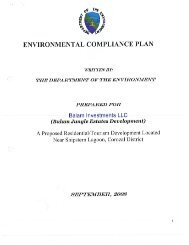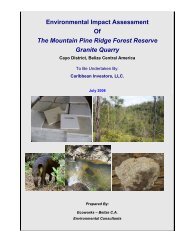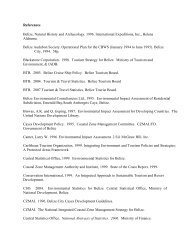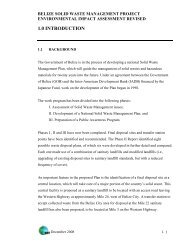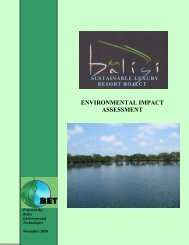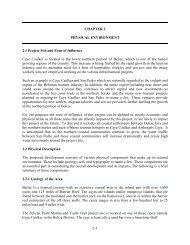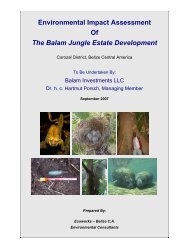Ambergris Caye Belize Resort Development - Department of ...
Ambergris Caye Belize Resort Development - Department of ...
Ambergris Caye Belize Resort Development - Department of ...
Create successful ePaper yourself
Turn your PDF publications into a flip-book with our unique Google optimized e-Paper software.
From the information in table 4.4, the project will source their water by means <strong>of</strong> rain<br />
water harvesting. The basic ro<strong>of</strong> catchment system will be augmented by recycling <strong>of</strong> the<br />
gray water produced by the various facilities. During periods <strong>of</strong> heavy water use the ro<strong>of</strong><br />
catchment will be augmented by the small reverse osmosis system.<br />
4.5 Source Supply Description<br />
The total potable water demand for the project will be about 40,070 gallons a day at full<br />
development and operation. This volume will be the initial capital water supply<br />
requirement for the project and this volume is expected to be reduced as recycled and<br />
desalted water is used to supplement the existing demand. The sources will be as follows:<br />
1- Main Source: Potable water for operation will be gotten from rain water<br />
harvesting. Since the project will consist primarily <strong>of</strong> condos, villas and other<br />
buildings, rain water sequestered from individual ro<strong>of</strong>s will be stored under<br />
buildings in cisterns designed as integral structural elements <strong>of</strong> the foundation<br />
structure. Each building will have its own rain water cistern along with all the<br />
necessary equipment needed to supply the building with water. The ro<strong>of</strong> <strong>of</strong> the<br />
buildings will harvest the water where it will be conveyed to the foundation via<br />
gutters and pipes. A small in line filtration system will be installed on each<br />
building to treat the water. Potable water for the water cabanas will be gotten<br />
from the activation <strong>of</strong> the R.O. plant. Water transmission lines will be laid<br />
underneath the piers and branched <strong>of</strong>f to each cabana.<br />
2- Secondary Source: In case <strong>of</strong> water shortage due to over consumption, as could be<br />
the case during the dry months, water can be gotten from the activation <strong>of</strong> the<br />
Water desalinization plant installed in the utility zone and transported to the<br />
desired area. The volume generated by this process will be small to medium and<br />
will be used as a back up source to drinking water, and to supply water to the<br />
pools, spa, kitchen, restaurants and bars. This will also be the primary source for<br />
the construction phases. The RO Unit to be deployed will yield 3,000 gallons/day.<br />
The desalted water will be chlorinated and stored in a 5,000 gallons ground<br />
reservoir.<br />
3- Tertiary Source: The basic ro<strong>of</strong> catchment system will be augmented by recycling<br />
<strong>of</strong> the gray water produced by the various facilities for such heavy water<br />
consumptive uses as toilet flushing, landscaping and other non-potable use. The<br />
treated (chlorinated) wastewater will be stored in a 10,000 gallons tank and sent to<br />
the different areas to be used as required. For the flushing <strong>of</strong> toilets a color coded<br />
water transmission line will be facilitating this process. Table 4.6 shows the<br />
volume required by the project to enable this water to be used for the required<br />
purpose.<br />
4- Construction Demand: It is difficult to ascertain the volume <strong>of</strong> water required for<br />
construction purposes. Moreover, the daily demand required for the construction<br />
workers since they may vary depending on the work load or construction<br />
4-4




